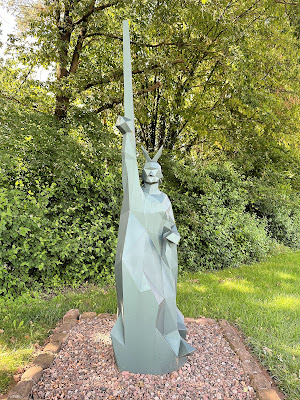
|
| The train I just left at Hövelhof Station is heading to Paderborn. |
I looked on the Internet and discovered that Karl Epping's meat factory had disappeared. Still, at the same site, Epping Green Energy was now located, i.e., from pork to photovoltaics or sausages to solar modules.

|
| Click to enlarge (©Google Maps) |
I rushed to the address and rang the bell. The door opened, and I looked up to a man standing 6 feet 8 inches. "You must be the grandson," I murmured.
Markus Epping, CEO of Epping Green Energy, invited me in and offered me a coffee.

|
| ©Epping Green Energy |
And then, I mostly talked about my childhood stay at the housing complex his grandfather Karl had built outside Hövelhof, now called Eppinghof. I told Markus I had spent one night with my mother and brother at his grandparents' house. On short notice, the British occupiers had ordered all people to leave their homes at Eppinghof to make room for Jewish women. They didn't come, so we could all return to our lodgings the following day.
The local church was the next stop on my visit to Hövelhof, but Markus warned me not to be disappointed. The complex was completely rebuilt in 1979 except for the two steeples.

|
| New St Nepomuk's vast interior is in bungalow style, looking at the former main entrance. |

|
| Red Baron likes to light candles. |
St. Nepomuk halfway up the wall, contemplating the cross. Why does Hövelhof honor a bridge saint without a significant stretch of running water? Read Nepomuk's legend here.

|
| Click to enlarge (©Google Maps) |

|
| Did I remember this prayer station on my way to school? |

|
|
In 1945, only the houses on the outside of the street called
Eppinghof - the odd numbers - were built. Click to enlarge (©Google Maps) |
Turning around the corner, I saw the first Eppinghof house built. It is still in its original state. There, where the trailer is parked, we children were playing in the sand when a low-flying plane approached over the gable of the house and strafed us.
House 23, where we lived, was transformed into a bungalow. However, the two windows on the first floor and the entrance door are still in their original positions.
Down the street, I found what I was looking for. Forget about the solar panels (Epping Green Energy?) and the skylights. The window on the house's gable is that of our kitchen/living room. Most impressively, on the outer wall of the gable wall, you can still see the square where the small window for venting the only mutual toilet used to be.

|
| ©ludger 1961/Wikipedia |
The Mahn- und Gedenkstätte für die Opfer von Krieg und Gewaltherrschaft (Memorial for the victims of war and tyranny) dominates the center of the site.
Here, as an example of the steles surrounding the memorial, the stele marked 1944 is shown when little Manfred came to Hövelhof.
A recent Hövelhof attraction is Hermann der Kantige (Hermann the Edgy). Red Baron blogged the story of Hermann the Cheruscan, also known as Arminius, and the Edgy is just a reminiscence of the original memorial near Detmold about which I blogged.
In the evening, Red Baron went to Hövelmarkt and had dinner at the Einstein. This central square is an attraction of the village.













Thanks for your enthusiasm and dedication in writing this blog
ReplyDelete